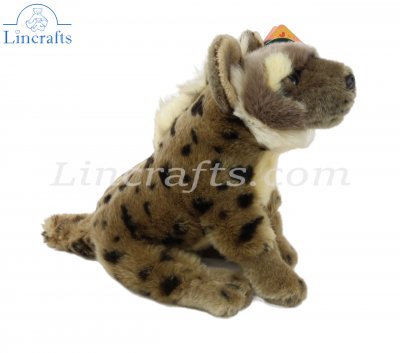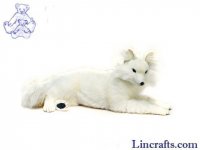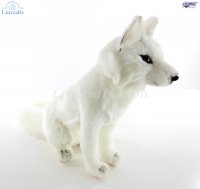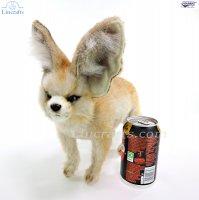Manufacturer: Living Nature
Category: Animals
Soft and cuddly Hyena soft toy by Living Nature
Shop now and ignite a love for nature while they play and snuggle with this delightful hyena friend. Ideal gift for animal lovers of all ages.
Size approx. 11" (28cm) in length and 9" (23cm) in height to the top of its head.
- Tag includes educational animal facts
- Suitable for all ages including from birth (0+ years)
- Care instructions: Hand wash only, do not machine wash or tumble dry
- Please remove all tags and attachments before giving to a child
- 10 year guarantee when registered with Living Nature
All Living Nature™ toys contain our Naturli eco-stuffing! The entire range uses 100% certified recycled plastics for either the stuffing or the whole toy.
1. They are adept hunters
One of the longest standing false accusations against the spotted hyena is that they are purely scavengers. Particularly that they steal most of their food from lions. In fact studies have shown that hyenas kill 66-90% of what they eat and when it comes to the actual hunt they are extremely versatile and successful hunters. As cursorial hunters, hyenas run down their prey to exhaustion, cruising at speeds of 37 mph (60 kph) for several miles. Spotted hyenas can bring down prey many times their size, for an animal the size of a large dog, they have been recorded to kill cape buffalo and giraffes.
As for the lions who are the supposed providers for the inept hyena, in multiple studies it has been shown the lions are more likely to scavenge from hyena kills, owing to the hyena's higher success rate.
2. They are great mothers
When thinking of nature’s great mothers, a gorilla nestling her young baby in her arms or a cat nursing her kittens may come to mind; usually not a spotted hyena. However hyenas surprisingly are one of the best mothers in the animal kingdom, investing more energy per cub than any other terrestrial carnivore. Hyenas give birth to 1 to 3 tiny jet black cubs (some call them pups, but early naturalists thought they resembled bear cubs). Hyena cubs are “precocial”, meaning they are born in a more advanced stage of development with their eyes open, teeth intact, and muscles ready to go, unlike many of the cat species where cubs are born largely blind and helpless for several weeks.
Spotted hyena mothers produce extremely fat and protein-rich milk (richer than any other terrestrial carnivore) and they produce a lot of it for a long period. Hyena cubs are completely dependent on milk for the first six months of their lives and will continue to nurse for up to another year. All of that is a lot of stress on a single mother as hyenas do not cross-suckle, even between closely related females.
3. They are amazingly intelligent
Often cast as being foolish and dull, perhaps due to the misunderstanding of their laugh or giggle vocalization, spotted hyenas show shocking signs of intelligence that rivals most wild animals in Africa. In fact hyena intelligence is thought to mimic the evolution of our own intelligence, with success through complex social behaviors driving brain evolution. In experiments spotted hyenas out performed even chimpanzees when it came to collective or group problem solving; showing that in some ways hyena intelligence may even exceed some of the great apes in certain aspects. Anyone who has spent any time with spotted hyenas in the wild can attest to their curious and inquisitive behavior; certainly anyone who’s had their car or house broken into by one. I’ve even observed rudimentary tool-use by hyena to achieve goals such as escaping from cage traps.
4. They can count
Studies have shown that spotted hyenas can determine the number of other hyenas in a rival clan and decide their best course of action. Similarly, males looking to join a new clan will always join the clan with the least number of other males after doing a quick census. It may not be calculus, but spotted hyenas are able to count.
5. The females have complicated and unusual genitals
Arguably the worst false accusation against hyenas is that they are hermaphrodites. This is completely false, but there's a very good reason why it was thought to be true. Female spotted hyenas do in fact have a pseudopenis and a pseduoscotum, both of which are convincingly similar to male anatomy. The pseudopenis is actually her clitoris, which has evolved to mimic the male’s anatomy with the entire urogential track running through it. Females urinate, have sex, and give birth through this structure. The reason for this male mimicry is not completely understood, but likely has its evolutionary history rooted in the benefits of looking like and even being confused as a male. One idea is that during the course of hyena evolution, males were far more aggressive, so much so that females who started to mimic them in appearance, size, and even genital anatomy were more successful at passing on their genes.
6. They have powerful jaws
A bite that can kill and also crush bones. Spotted hyena jaws have evolved colossal masseter (jaw) muscles to be able to produce massive amounts of force in a specific section of their dentition; the molars and premolars. With the ability to exert over 1,100 psi or around 9,000 newtons (depending on the studies you read), spotted hyenas can crack open bones nearly 2 ½ inches in diameter. This allows hyenas to access the nutrient-rich marrow inside that is inaccessible to most other animals.
7. They’re remarkably long living
Unlike dogs and other canine species which can live for 6-10 years or even wild felids like lions and tigers that can live to 10-15, spotted hyenas can get into their 20’s in the wild, making them some of the longest living terrestrial carnivores. It takes 35 months to reach 95% skull maturity, which is one of the most protracted skull growths of large carnivores after sexual maturity. The longest recorded living spotted hyena was in captivity and lived to 41 years and 1 month old!
8. They have a history of conquering
Even in their current range, spotted hyenas are arguably one of the most successful large carnivores, ranging across the majority of continental Africa in a diverse range of habitats. However going back 10-20,000 years ago the Eurasian spotted hyena, which likely was the same species if not a subspecies of the hyenas we see today, ranged from the British Isles to Eastern Siberia. The spotted hyena dominated large portions of three continents and directly competed with humans for resources and caves. It’s even thought that the presence of hyenas in Siberia prevented the spread of humans into the Americas across the Bering Strait!
9. They are tremendously socially complex
Living in social groups called clans that can contain as many as 130 individuals, spotted hyenas are quite sociable. However unlike a wolf pack or a lion pride, hyenas are rarely all together at once and instead are often found by themselves or in small groups, only meeting up from time to time. This is called a “fusion-fission” society. These clans are made up of largely related females who are the most dominant, their cubs who take on the rank directly below their mother, and non-natal males who have immigrated from other clans once reaching sexual maturity. These immigrant males take the lowest social ranks, in order of their arrival to the clan, and are even outranked by newborn cubs, since rank is reinforced by the mother’s by force. This type of linear social ranking is extremely similar to old world monkeys, but the female dominance is quite unique for a large carnivore. Within the clan there is a matriarch who is the most socially dominant female who leads the clan, but there is also a complex social network of friendships and even political alliances, which become even more apparent when the matriarch dies and a power vacuum ensues.
10. They’re vocal
The spotted hyena has a vocal repertoire unlike any other carnivore, largely in part due to their complex social nature. Best known for their laugh or giggle, the spotted hyena has often been called the “laughing hyena”, but the laugh isn’t funny, in general it’s an expression of social anxiety and uncertainty.




















